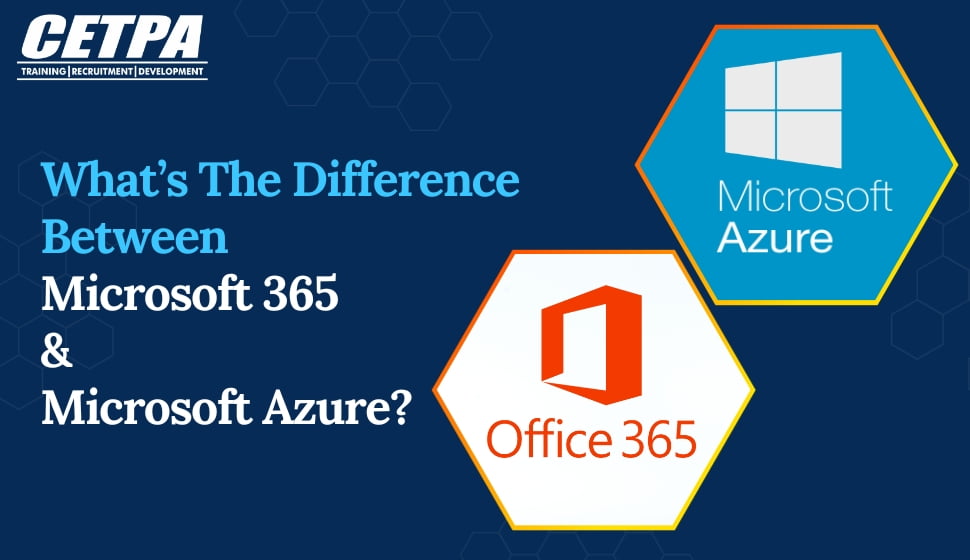What’s The Difference Between Microsoft 365 and Microsoft Azure?

An Introduction to Microsoft 365 and Microsoft Azure:
In the rapidly changing technological environment, cloud computing is a transformative powerhouse, improving businesses by enhancing productivity, scalability, and collaboration. Microsoft, a leader in the industry, spearheads this revolution with two essential cloud services: Microsoft 365 and Microsoft Azure. Despite bearing the Microsoft logo, many systems are tailored to specific organizational needs.
Microsoft 365, earlier popular as Office 365, is a complete set curated for improving regular productivity and collaboration. It is built on popular Office products and provides safe, cloud-based file storage via OneDrive for Business. On the contrary, Microsoft Azure is popular as a dynamic cloud computing platform curated for wider infrastructure requirements. From IaaS and PaaS to robust data services and cutting-edge AI, Azure equips businesses to scale, innovate, and deploy applications across the globe.
In the following blog, we will examine the differences between these Microsoft products in detail. The primary goal is to provide organizations with the information they need to efficiently navigate their individual cloud strategies. We also encourage individuals to attend our renowned Microsoft Azure training in Noida.
A Comprehensive Distinction Between Microsoft 365 and Microsoft Azure:
A detailed differentiation between Microsoft 365 and Microsoft Azure is given below for aspiring individuals and businesses:
Microsoft Azure –
The primary components of Microsoft Azure are:
- IaaS: Azure provides virtual machines, storage, and networking services allowing businesses to shift existing applications to cloud without managing physical hardware.
- PaaS: Azure’s PaaS offerings like Azure App Service simplify the development and deployment of applications. This is done by handling the underlying infrastructure, allowing developers to concentrate on coding.
- Data Services: Azure offers a variety of data services, including relational and NoSQL databases, data warehouses, etc. This empowers businesses to derive valuable information from their data.
- AI and ML: Azure involves AI and ML services, like Azure Machine Learning and Cognitive Services. This allows organizations to combine intelligent capabilities into their applications.
- IoT: Azure IoT Hub and Azure IoT Central promote the development and management of IoT solutions, connecting devices, analyzing information, etc.
Microsoft 365 –
The primary components of Microsoft 365 are:
- Office Apps: Microsoft 365 incorporates connected Office applications such as Word, Excel, PowerPoint, etc. This allows users to build, edit, and share documents in real time.
- Communication Tools: Microsoft Teams promotes instant messaging, video conferencing, etc. This encourages a dynamic and connected work environment throughout the organization.
- Cloud Storage: OneDrive for Businesses offers safe cloud storage, permitting users to access their files from anywhere and collaborate with documents in real time.
- Collaboration and Productivity Tools: SharePoint and OneNote are essential to Microsoft 365 offering powerful tools for team collaboration, document management, and note-taking.
- Security and Compliance Features: Microsoft 365 includes advanced security features for securing sensitive data and guaranteeing compliance with regulatory standards.
Choosing The Correct Cloud Solution: Microsoft Azure Vs. Microsoft 365:
In the complex landscape of cloud solutions, businesses face a crucial challenge while choosing between Microsoft 365 and Microsoft Azure. This is because each solution caters to distinct factors of their operational environment. Those who value enhancing everyday processes, cooperation, and communication can opt for Microsoft Dynamics 365 Training in Noida. As introduced in this training, the Microsoft Dynamics 365 suite is a catalyst for productivity improvement. On the contrary, individuals aspiring for a dynamic, scalable cloud environment, find their desirable company in Microsoft Azure. Azure, as a flexible cloud computing platform, offers IaaS, PaaS, and a range of data services, unlocking tremendous creative potential.
However, the story doesn’t end there. Microsoft 365 and Azure, in spite of their different focuses, comprise a symbiotic relationship that is used for a comprehensive cloud strategy. This combination changes the dichotomy into a harmonious synergy. Businesses, using Microsoft 365 for regular productivity tools, can smoothly tap into Azure’s prowess. This involves hosting custom applications, handling databases, and orchestrating backend services. The combination of these platforms creates a strong ecosystem in which productivity, scalability, and innovation coexist to provide enterprises with a comprehensive and flexible cloud solution.
To summarize, the contradiction between Microsoft 365 and Azure isn’t a choice of one over the other. Instead, it is an exploration of how these platforms can jointly escalate an organization into a future where efficacy, collaboration, and innovation integrate effortlessly in the cloud.
Conclusion:
To conclude, Microsoft 365 and Microsoft Azure are critical components of Microsoft’s cloud solutions. Each of the two provides separate goals in the realms of productivity and infrastructure. Therefore, understanding the distinctions between the two is critical for businesses to make informed decisions that are in line with their unique objectives. Microsoft’s complete cloud ecosystem covers the various requirements of modern companies, whether it’s collaboration with Microsoft 365 or the use of scalable cloud solutions with Azure.



